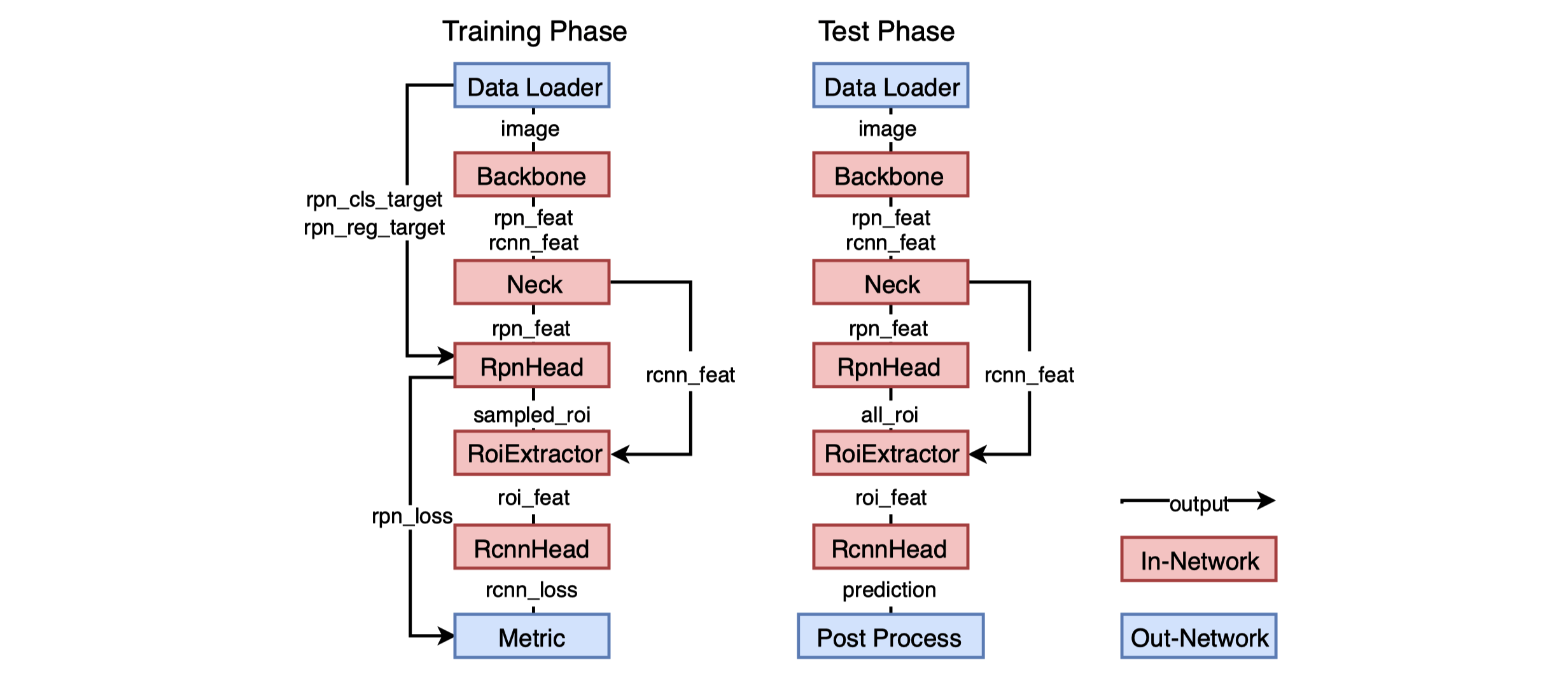- FP16 training for memory saving and up to 2.5X acceleration
- Highly scalable distributed training available out of box
- Full coverage of state-of-the-art models including FasterRCNN, MaskRCNN, CascadeRCNN, RetinaNet, DCNv1/v2, TridentNet, NASFPN , EfficientNet, and Kownledge Distillation
- Extensive feature set including large batch BN, loss synchronization, automatic BN fusion, soft NMS, multi-scale train/test
- Modular design for coding-free exploration of new experiment settings
- Extensive documentations including annotated config, Fintuning Guide
- Add RPN test (2019.05.28)
- Add NASFPN (2019.06.04)
- Add new ResNetV1b baselines from GluonCV (2019.06.07)
- Add Cascade R-CNN with FPN backbone (2019.06.11)
- Speed up FPN up to 70% (2019.06.16)
- Update NASFPN to include larger models (2019.07.01)
- Automatic BN fusion for fixed BN training, saving up to 50% GPU memory (2019.07.04)
- Speed up MaskRCNN by 80% (2019.07.23)
- Update MaskRCNN baselines (2019.07.25)
- Add EfficientNet and DCN (2019.08.06)
- Add python wheel for easy local installation (2019.08.20)
- Add FitNet based Knowledge Distill (2019.08.27)
- Add SE and train from scratch (2019.08.30)
- Add a lot of docs (2019.09.03)
- Add support for INT8 training (2019.10.24)
We provide a setup script for install simpledet and preppare the coco dataset. If you use this script, you can skip to the Quick Start.
We provide a conda installation here for Debian/Ubuntu system. To use a pre-built docker or singularity images, please refer to INSTALL.md for more information.
# install dependency
sudo apt update && sudo apt install -y git wget make python3-dev libglib2.0-0 libsm6 libxext6 libxrender-dev unzip
# create conda env
conda create -n simpledet python=3.7
conda activate simpledet
# fetch CUDA environment
conda install cudatoolkit=10.1
# install python dependency
pip install 'matplotlib<3.1' opencv-python pytz
# download and intall pre-built wheel for CUDA 10.1
pip install https://1dv.alarge.space/mxnet_cu101-1.6.0b20190820-py2.py3-none-manylinux1_x86_64.whl
# install pycocotools
pip install 'git+https://github.com/RogerChern/cocoapi.git#subdirectory=PythonAPI'
# install mxnext, a wrapper around MXNet symbolic API
pip install 'git+https://github.com/RogerChern/mxnext#egg=mxnext'
# get simpledet
git clone https://github.com/tusimple/simpledet
cd simpledet
make
# test simpledet installation
mkdir -p experiments/faster_r50v1_fpn_1x
python detection_infer_speed.py --config config/faster_r50v1_fpn_1x.py --shape 800 1333If the last line execute successfully, the average running speed of Faster R-CNN R-50 FPN will be reported. And you have successfuly setup SimpleDet. Now you can head up to the next section to prepare your dataset.
We provide a step by step preparation for the COCO dataset below.
cd simpledet
# make data dir
mkdir -p data/coco/images data/src
# skip this if you have the zip files
wget -c http://images.cocodataset.org/zips/train2017.zip -O data/src/train2017.zip
wget -c http://images.cocodataset.org/zips/val2017.zip -O data/src/val2017.zip
wget -c http://images.cocodataset.org/zips/test2017.zip -O data/src/test2017.zip
wget -c http://images.cocodataset.org/annotations/annotations_trainval2017.zip -O data/src/annotations_trainval2017.zip
wget -c http://images.cocodataset.org/annotations/image_info_test2017.zip -O data/src/image_info_test2017.zip
unzip data/src/train2017.zip -d data/coco/images
unzip data/src/val2017.zip -d data/coco/images
unzip data/src/test2017.zip -d data/coco/images
unzip data/src/annotations_trainval2017.zip -d data/coco
unzip data/src/image_info_test2017.zip -d data/coco
python utils/create_coco_roidb.py --dataset coco --dataset-split train2017
python utils/create_coco_roidb.py --dataset coco --dataset-split val2017
python utils/create_coco_roidb.py --dataset coco --dataset-split test-dev2017For other datasets or your own data, please check DATASET.md for more details.
# train
python detection_train.py --config config/faster_r50v1_fpn_1x.py
# test
python detection_test.py --config config/faster_r50v1_fpn_1x.pyPlease check FINTUNE.md
Please refer to MODEL_ZOO.md for available models
Please refer to DISTRIBUTED.md
detection_train.py
detection_test.py
config/
detection_config.py
core/
detection_input.py
detection_metric.py
detection_module.py
models/
FPN/
tridentnet/
maskrcnn/
cascade_rcnn/
retinanet/
mxnext/
symbol/
builder.py
Everything is configurable from the config file, all the changes should be out of source.
One experiment is a directory in experiments folder with the same name as the config file.
E.g. r50_fixbn_1x.py is the name of a config file
config/
r50_fixbn_1x.py
experiments/
r50_fixbn_1x/
checkpoint.params
log.txt
coco_minival2014_result.json
The models directory contains SOTA models implemented in SimpletDet.
Simpledet supports many popular detection methods and here we take Faster R-CNN as a typical example to show how a detector is built.
- Preprocessing. The preprocessing methods of the detector is implemented through
DetectionAugmentation.- Image/bbox-related preprocessing, such as
Norm2DImageandResize2DImageBbox. - Anchor generator
AnchorTarget2D, which generates anchors and corresponding anchor targets for training RPN.
- Image/bbox-related preprocessing, such as
- Network Structure. The training and testing symbols of Faster-RCNN detector is defined in
FasterRcnn. The key components are listed as follow:- Backbone.
Backboneprovides interfaces to build backbone networks, e.g. ResNet and ResNext. - Neck.
Neckprovides interfaces to build complementary feature extraction layers for backbone networks, e.g.FPNNeckbuilds Top-down pathway for Feature Pyramid Network. - RPN head.
RpnHeadaims to build classification and regression layers to generate proposal outputs for RPN. Meanwhile, it also provides interplace to generate sampled proposals for the subsequent R-CNN. - Roi Extractor.
RoiExtractorextracts features for each roi (proposal) based on the R-CNN features generated byBackboneandNeck. - Bounding Box Head.
BboxHeadbuilds the R-CNN layers for proposal refinement.
- Backbone.
The flexibility of simpledet framework makes it easy to build different detectors. We take TridentNet as an example to demonstrate how to build a custom detector simply based on the Faster R-CNN framework.
- Preprocessing. The additional processing methods could be provided accordingly by inheriting from
DetectionAugmentation.- In TridentNet, a new
TridentAnchorTarget2Dis implemented to generate anchors for multiple branches and filter anchors for scale-aware training scheme.
- In TridentNet, a new
- Network Structure. The new network structure could be constructed easily for a custom detector by modifying some required components as needed and
- For TridentNet, we build trident blocks in the
Backboneaccording to the descriptions in the paper. We also provide aTridentRpnHeadto generate filtered proposals in RPN to implement the scale-aware scheme. Other components are shared the same with original Faster-RCNN.
- For TridentNet, we build trident blocks in the
Yuntao Chen, Chenxia Han, Yanghao Li, Zehao Huang, Yi Jiang, Naiyan Wang
This project is release under the Apache 2.0 license for non-commercial usage. For commercial usage, please contact us for another license.
If you find our project helpful, please consider cite our tech report.
@article{chen2019simpledet,
title={SimpleDet: A Simple and Versatile Distributed Framework for Object Detection and Instance Recognition},
author={Chen, Yuntao and and Han, Chenxia and Li, Yanghao and Huang, Zehao and Jiang, Yi and Wang, Naiyan and Zhang, Zhaoxiang},
journal={Journal of Machine Learning Research(156):1−8, 2019},
year={2019}
}

